Unit 6 When was it invented ?Section A Grammar Focus-4c课件2022-2023学年人教版九年级全一册英语(共19张PPT)
文档属性
| 名称 | Unit 6 When was it invented ?Section A Grammar Focus-4c课件2022-2023学年人教版九年级全一册英语(共19张PPT) | 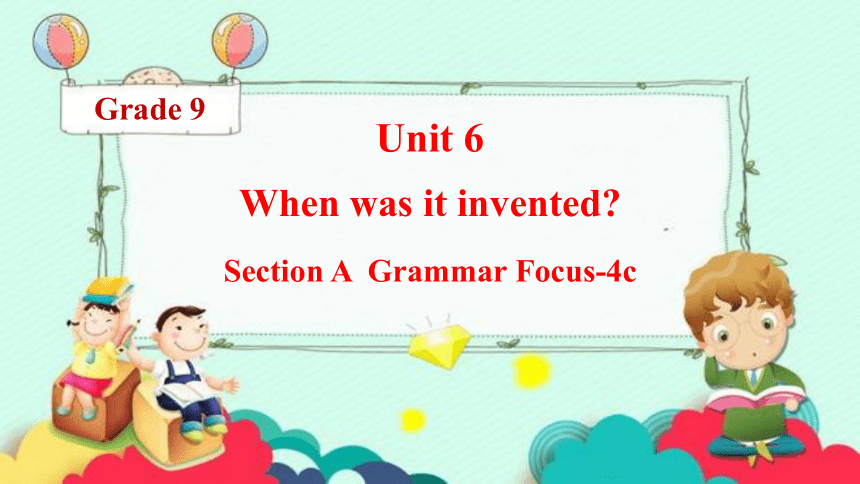 | |
| 格式 | zip | ||
| 文件大小 | 704.3KB | ||
| 资源类型 | 教案 | ||
| 版本资源 | 人教新目标(Go for it)版 | ||
| 科目 | 英语 | ||
| 更新时间 | 2022-10-03 15:25:03 | ||
图片预览

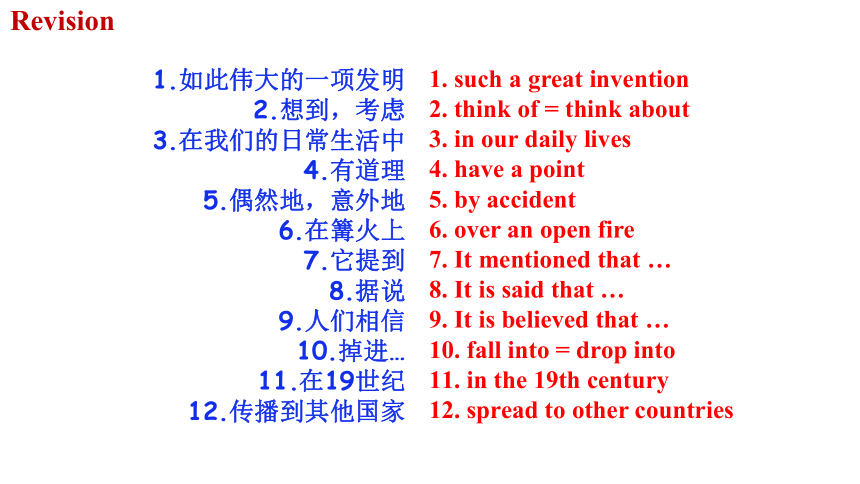

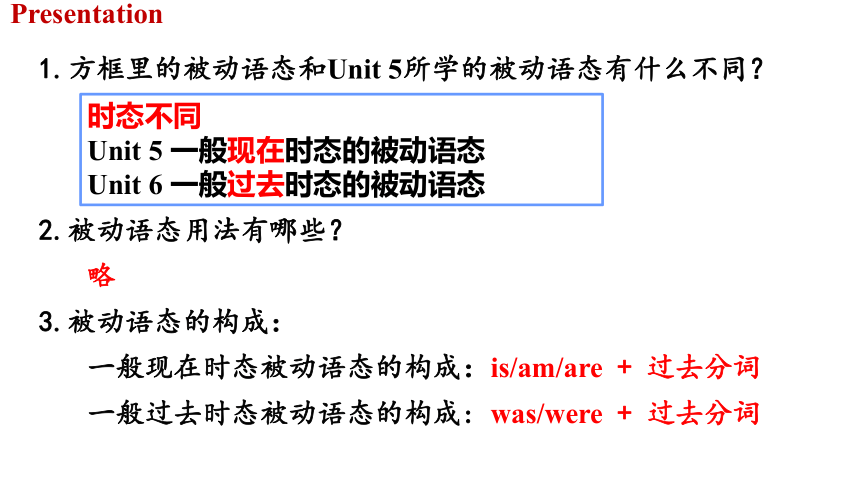
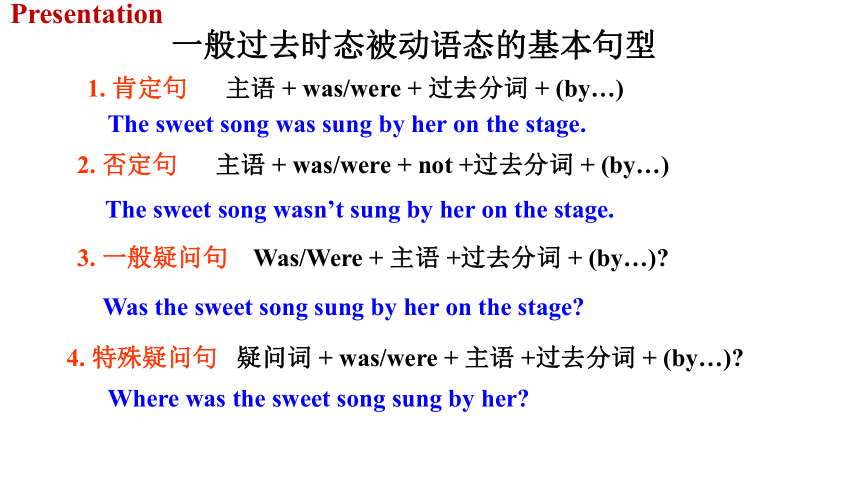
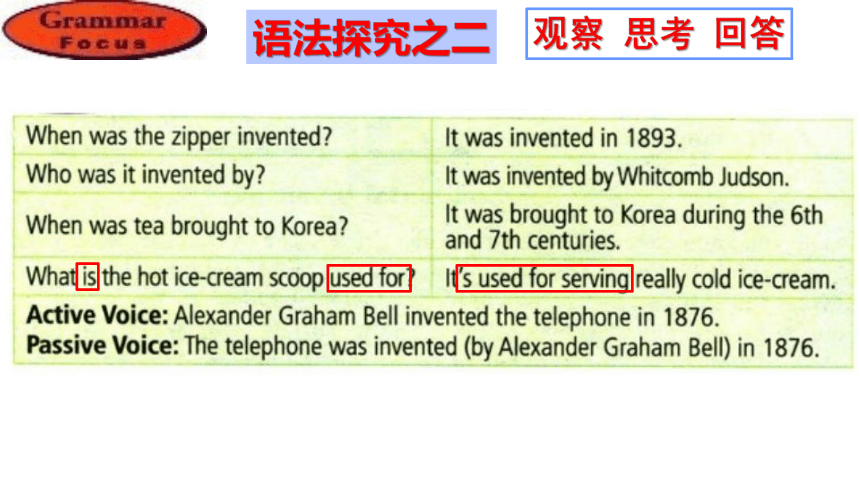
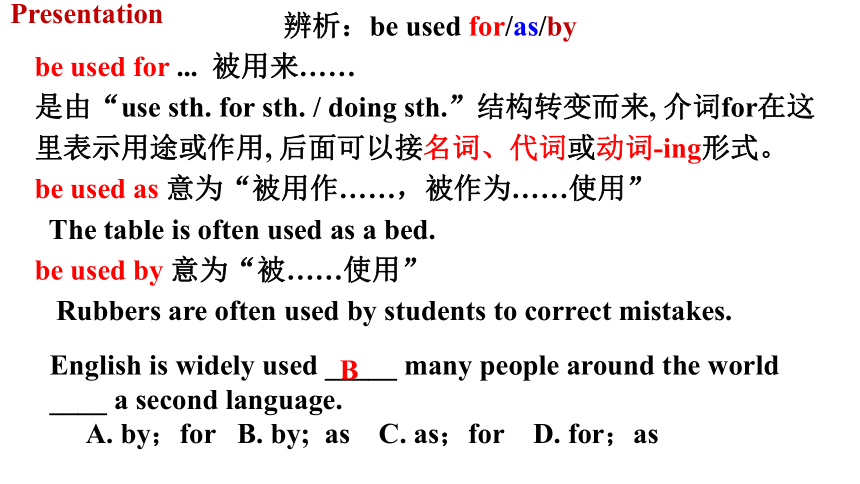
文档简介
(共19张PPT)
Grade 9
Unit 6
When was it invented
Section A Grammar Focus-4c
1.如此伟大的一项发明
2.想到,考虑
3.在我们的日常生活中
4.有道理
5.偶然地,意外地
6.在篝火上
7.它提到
8.据说
9.人们相信
10.掉进…
11.在19世纪
12.传播到其他国家
1. such a great invention
2. think of = think about
3. in our daily lives
4. have a point
5. by accident
6. over an open fire
7. It mentioned that …
8. It is said that …
9. It is believed that …
10. fall into = drop into
11. in the 19th century
12. spread to other countries
Revision
语法探究之一
观察 思考 回答
Presentation
1.方框里的被动语态和Unit 5所学的被动语态有什么不同?
时态不同
Unit 5 一般现在时态的被动语态
Unit 6 一般过去时态的被动语态
2.被动语态用法有哪些?
略
3.被动语态的构成:
一般现在时态被动语态的构成:is/am/are + 过去分词
一般过去时态被动语态的构成: was/were + 过去分词
一般过去时态被动语态的基本句型
1. 肯定句 主语 + was/were + 过去分词 + (by…)
The sweet song was sung by her on the stage.
2. 否定句 主语 + was/were + not +过去分词 + (by…)
3. 一般疑问句 Was/Were + 主语 +过去分词 + (by…)
The sweet song wasn’t sung by her on the stage.
Was the sweet song sung by her on the stage
4. 特殊疑问句 疑问词 + was/were + 主语 +过去分词 + (by…)
Where was the sweet song sung by her
Presentation
语法探究之二
观察 思考 回答
辨析:be used for/as/by
be used for ... 被用来……
是由“use sth. for sth. / doing sth.”结构转变而来, 介词for在这里表示用途或作用, 后面可以接名词、代词或动词-ing形式。
be used as 意为“被用作……,被作为……使用”
The table is often used as a bed.
be used by 意为“被……使用”
Rubbers are often used by students to correct mistakes.
Presentation
English is widely used _____ many people around the world ____ a second language.
A. by;for B. by; as C. as;for D. for;as
B
辨析:
be used for doing sth. be used to do sth.
be used to doing sth used to do sth.
Presentation
1. be used for doing sth.意为:被用来做某事
2. be used to do sth 意为:被用来做某事
=be used for doing sth.
区别:for 是介词,后面的动词必须要用-ing形式;
to是动词不定式结构,动词要用原形形式。
3. be used to doing sth. 意为:习惯于做某事
4. used to do sth. 意为:过去常常做某事
牛刀小试
He is a good man, because he ______.
A was used to helping others.
B is used to help others.
C is used to helping others.
D used to help others.
C
语法探究之三
观察 思考 回答
一般过去时态的句子怎么变为被动语态?
We bought some books.
主动句与被动句之间的转换
Some books were bought ( by us )
主语 谓语动词主动语态的过去式 宾语
主语 谓语动词被动语态的过去分词 介词+ 宾语
Presentation
主动句变为被动句所遵循的4个步骤:
1. 把原主动句中的宾语变为被动句的主语。
2. 把动词变为被动形式即be+过去分词,并注意其人称和数随主语的变化,而动词的时态则保持不变。
3. 原主动句的主语如需要则放在by后面,(注意:人称
代词改为宾格),如不需要则可省略。
4. 其它的成分(定语、状语)不变。
Presentation
感官动词和使役动词在主动句中后面有省略to的不定式做宾语补足语的,改为被动句后,动词原形前要加to
被动语态:The doctor made my father give up smoking.
被动语态:My father was made to give up smoking.
Presentation
主动句变为被动句高频考点
使役动词有:make, let, have
感官动词有:see, watch, notice, hear, listen to…
Practice
My camera was stolen from my hotel room (by somebody).
Where were these photos taken
We were advised by our parents not to go out alone.
The book was translated into different languages by different writers.
Practice
were invited
were brought
was locked
rang
were told
broke
were eaten
liked
Practice
was invented
was born
worked
learnt
was invented
was said
is used
单项选择
1. --- Today Chinese is becoming more and more popular.
--- It _______ in many schools around the world.
A. teaches B. is teaching C. has taught D. is taught
2. We _______ to close the windows before we left the lab.
A. tell B. told C. are told D. were told
3. --- Did you hear that water in Tai Lake smelt terrible
--- Yes. In fact, it _______. That's all because of the people and
the factories around.
A. polluted B. was polluted
C. has polluted D. will pollute
D
Exercises
D
B
将下列句子变为被动语态
1. They built my house last year.
2. We often hear the girl sing happily in her room.
My house was built last year.
Exercises
The girl is often heard to sing happily (by us) in her room.
Finish the exercises in the woekbooks.
Homework
Grade 9
Unit 6
When was it invented
Section A Grammar Focus-4c
1.如此伟大的一项发明
2.想到,考虑
3.在我们的日常生活中
4.有道理
5.偶然地,意外地
6.在篝火上
7.它提到
8.据说
9.人们相信
10.掉进…
11.在19世纪
12.传播到其他国家
1. such a great invention
2. think of = think about
3. in our daily lives
4. have a point
5. by accident
6. over an open fire
7. It mentioned that …
8. It is said that …
9. It is believed that …
10. fall into = drop into
11. in the 19th century
12. spread to other countries
Revision
语法探究之一
观察 思考 回答
Presentation
1.方框里的被动语态和Unit 5所学的被动语态有什么不同?
时态不同
Unit 5 一般现在时态的被动语态
Unit 6 一般过去时态的被动语态
2.被动语态用法有哪些?
略
3.被动语态的构成:
一般现在时态被动语态的构成:is/am/are + 过去分词
一般过去时态被动语态的构成: was/were + 过去分词
一般过去时态被动语态的基本句型
1. 肯定句 主语 + was/were + 过去分词 + (by…)
The sweet song was sung by her on the stage.
2. 否定句 主语 + was/were + not +过去分词 + (by…)
3. 一般疑问句 Was/Were + 主语 +过去分词 + (by…)
The sweet song wasn’t sung by her on the stage.
Was the sweet song sung by her on the stage
4. 特殊疑问句 疑问词 + was/were + 主语 +过去分词 + (by…)
Where was the sweet song sung by her
Presentation
语法探究之二
观察 思考 回答
辨析:be used for/as/by
be used for ... 被用来……
是由“use sth. for sth. / doing sth.”结构转变而来, 介词for在这里表示用途或作用, 后面可以接名词、代词或动词-ing形式。
be used as 意为“被用作……,被作为……使用”
The table is often used as a bed.
be used by 意为“被……使用”
Rubbers are often used by students to correct mistakes.
Presentation
English is widely used _____ many people around the world ____ a second language.
A. by;for B. by; as C. as;for D. for;as
B
辨析:
be used for doing sth. be used to do sth.
be used to doing sth used to do sth.
Presentation
1. be used for doing sth.意为:被用来做某事
2. be used to do sth 意为:被用来做某事
=be used for doing sth.
区别:for 是介词,后面的动词必须要用-ing形式;
to是动词不定式结构,动词要用原形形式。
3. be used to doing sth. 意为:习惯于做某事
4. used to do sth. 意为:过去常常做某事
牛刀小试
He is a good man, because he ______.
A was used to helping others.
B is used to help others.
C is used to helping others.
D used to help others.
C
语法探究之三
观察 思考 回答
一般过去时态的句子怎么变为被动语态?
We bought some books.
主动句与被动句之间的转换
Some books were bought ( by us )
主语 谓语动词主动语态的过去式 宾语
主语 谓语动词被动语态的过去分词 介词+ 宾语
Presentation
主动句变为被动句所遵循的4个步骤:
1. 把原主动句中的宾语变为被动句的主语。
2. 把动词变为被动形式即be+过去分词,并注意其人称和数随主语的变化,而动词的时态则保持不变。
3. 原主动句的主语如需要则放在by后面,(注意:人称
代词改为宾格),如不需要则可省略。
4. 其它的成分(定语、状语)不变。
Presentation
感官动词和使役动词在主动句中后面有省略to的不定式做宾语补足语的,改为被动句后,动词原形前要加to
被动语态:The doctor made my father give up smoking.
被动语态:My father was made to give up smoking.
Presentation
主动句变为被动句高频考点
使役动词有:make, let, have
感官动词有:see, watch, notice, hear, listen to…
Practice
My camera was stolen from my hotel room (by somebody).
Where were these photos taken
We were advised by our parents not to go out alone.
The book was translated into different languages by different writers.
Practice
were invited
were brought
was locked
rang
were told
broke
were eaten
liked
Practice
was invented
was born
worked
learnt
was invented
was said
is used
单项选择
1. --- Today Chinese is becoming more and more popular.
--- It _______ in many schools around the world.
A. teaches B. is teaching C. has taught D. is taught
2. We _______ to close the windows before we left the lab.
A. tell B. told C. are told D. were told
3. --- Did you hear that water in Tai Lake smelt terrible
--- Yes. In fact, it _______. That's all because of the people and
the factories around.
A. polluted B. was polluted
C. has polluted D. will pollute
D
Exercises
D
B
将下列句子变为被动语态
1. They built my house last year.
2. We often hear the girl sing happily in her room.
My house was built last year.
Exercises
The girl is often heard to sing happily (by us) in her room.
Finish the exercises in the woekbooks.
Homework
同课章节目录
- Unit 1 How can we become good learners.
- Section A
- Section B
- Unit 2 I think that mooncakes are delicious!
- Section A
- Section B
- Unit 3 Could you please tell me where the restroom
- Section A
- Section B
- Unit 4 I used to be afraid of the dark.
- Section A
- Section B
- Unit 5 What are the shirts made of?
- Section A
- Section B
- Review of Units 1-5
- Unit 6 When was it invented?
- Section A
- Section B
- Unit 7 Teenagers should be allowed to choose their
- Section A
- Section B
- Unit 8 It must belong to Carla.
- Section A
- Section B
- Unit 9 I like music that I can dance to.
- Section A
- Section B
- Unit 10 You're supposed to shake hands.
- Section A
- Section B
- Review of Units 6-10
- Unit 11 Sad movies make me cry.
- Section A
- Section B
- Unit 12 Life is full of the unexpected
- Section A
- Section B
- Unit 13 We're trying to save the earth!
- Section A
- Section B
- Unit 14 I remember meeting all of you in Grade 7.
- Section A
- Section B
- Review of Units 11-14
